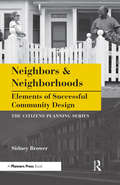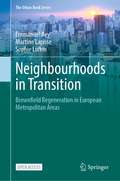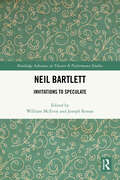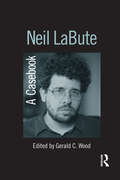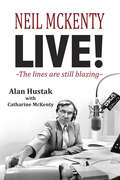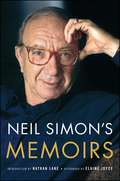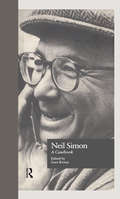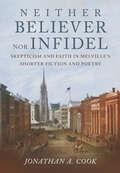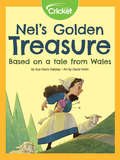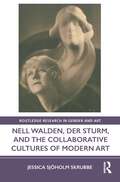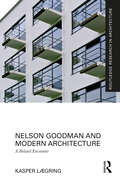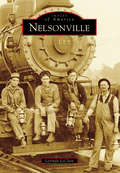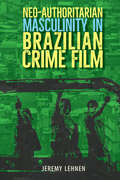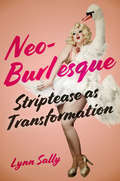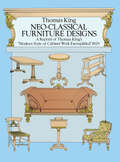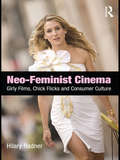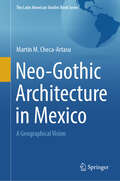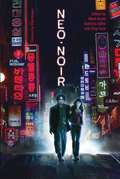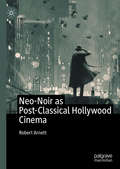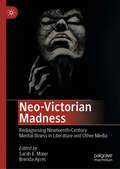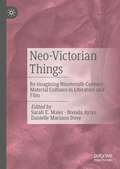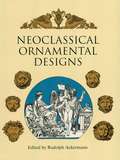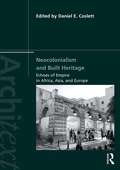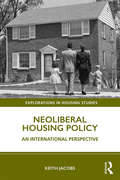- Table View
- List View
Neighbors and Neighborhoods: Elements of Successful Community Design
by Sidney BrowerHow does the design of a neighborhood affect the people who live there? In this thoughtful, engaging book, the author explains how a neighborhood’s design lays the groundwork for the social relationships that make it a community. Blending social science with personal interviews, the author shares the lessons of planned communities from historic Riverside, Illinois, to archetypal Levittown, New York, and Disney’s Celebration, Florida. Through these inspirational stories, readers will discover the characteristics of neighborhoods that promote the attitudes and behaviors of a healthy community. This volume is an eye-opener for everyone who’s wondered what makes their local neighborhoods tick. It demystifies the way planners, architects, developers, organizers, and citizens come together in crafting a community’s physical elements, policies, programs, and processes. Readers will come away with a new understanding of their roles in creating the communities they want.
Neighbourhoods in Transition: Brownfield Regeneration in European Metropolitan Areas (The Urban Book Series)
by Sophie Lufkin Emmanuel Rey Martine LapriseThis open access book is focused on the intersection between urban brownfields and the sustainability transitions of metreopolitan areas, cities and neighbourhoods. It provides both a theoretical and practical approach to the topic, offering a thorough introduction to urban brownfields and regeneration projects as well as an operational monitoring tool. Neighbourhoods in Transition begins with an overview of historic urban development and strategic areas in the hearts of towns to be developed. It then defines several key issues related to the topic, including urban brownfields, regeneration projects, and sustainability issues related to neighbourhood development. The second part of this book is focused on support tools, explaining the challenges faced, the steps involved in a regeneration process, and offering an operational monitoring tool. It applies the unique tool to case studies in three selected neighbourhoods and the outcomes of one case study are also presented and discussed, highlighting its benefits.The audience for this book will be both professional and academic. It will support researchers as an up-to-date reference book on urban brownfield regeneration projects, and also the work of architects, urban designers, urban planners and engineers involved in sustainability transitions of the built environment.
Neil Bartlett: Invitations to Speculate (Routledge Advances in Theatre & Performance Studies)
by William McEvoy Joseph RonanThis book explores Neil Bartlett’s groundbreaking contributions to queer cultural production in the United Kingdom. It adopts a range of critical perspectives, presenting original scholarship on Bartlett’s fiction, theatre, performance, site-specific work, and adaptations, as well as more personal reflections on Bartlett’s influence and legacy.Charting his emergence as a radical queer artist in the 1970s, his writing for performance and theatre in the 1980s to the present day, and his evocative novels about queer spaces and hidden histories, the book considers Bartlett’s works as ‘invitations to speculate’: to view and imagine otherwise, as part of a political aesthetics committed to making queer lives visible. Bartlett’s bold, sensuous, and challenging work crosses genres to find new ways of articulating queer desires, unearthing histories of the body, pleasure, and gay subjectivity while connecting queer experiences across time.Dealing with topics including memory and loss, AIDS and its legacy, marginality, community, and identity, the collection shows how Bartlett embraces the past as a way of reimagining queer futures and demonstrates his status as one of the UK’s leading queer artists.
Neil LaBute: A Casebook (Casebooks on Modern Dramatists)
by Gerald C. WoodNeil LaBute: A Casebook is the first book to examine one of the most successful and controversial contemporary American playwrights and filmmakers. While he is most famous, and in some cases infamous, for his early films In the Company of Men and Your Friends and Neighbors, Labute is equally accomplished as a playwright. His work extends from the critique of false religiosity in Bash to examinations of opportunism, irresponsible art, failed parenting, and racism in later plays like Mercy Seat, The Shape of Things, The Distance From Here, Fat Pig, Autobahn, and the very recent This Is How It Goes and Some Girls. Like David Mamet, an acknowledged influence on him, and Conor McPhereson, with whom he shares some stylistic and thematic concerns, LaBute tends to polarize audiences. The angry voices, violent situations, and irresponsible behavior in his works, especially those focusing on male characters, have alienated some viewers. But the writer's religious affiliation and refusal to condone the actions of his characters suggest he is neither exploitive nor pornographic. This casebook explores the primary issues of the writer's style, themes, and dramatic achievements. Contributors describe, for example, the influences (both classical and contemporary) on his work, his distinctive vision in theater and film, the role of religious belief in his work, and his satire. In addition to the critical introduction by Wood and the original essays by leading dramatic and literary scholars, the volume also includes a bibliography and a chronology of the playwright's life and works.
Neil McKenty Live: The lines are still blazing
by Catharine Mckenty Alan HustakNeil McKenty liked to argue just for the hell of it. During the 1970's and 80s he was one of Montreal's highest rated radio talk show hosts. At the peak of his career more than 75,000 people tuned in to CJAD to hear his show, Exchange. 'The basic exchange on Exchange, is not between the listeners and Neil McKenty," he once explained. "It is between the listeners. If the host sets up the chemistry, the show goes on its own momentum, and I am almost on the sidelines. On the other hand, I am in the entertainment business. If I bore my listeners, I'm dead." The material collected in this book focuses on the years he moderated, infuriated, provoked and entertained his listeners.
Neil Simon's Memoirs
by Neil SimonThe complete memoirs of playwright Neil Simon--the author of such iconic works as Lost in Yonkers, The Odd Couple, Biloxi Blues, and The Goodbye Girl--now with a new introduction and afterword.This omnibus edition combines Neil Simon's two memoirs, Rewrites and The Play Goes On, into one volume that spans his extraordinary five-decade career in theater, television, and film. Rewrites takes Simon through his first love, his first play, and his first brush with failure. There is the humor of growing up in Washington Heights (the inspiration for his play Brighton Beach Memoirs) where, despite his parents' rocky marriage and many separations, he learned to see the funny side of family drama, as when his mother screamed thinking she saw a body on the floor in their apartment--it turned out to be the clothes his father discarded in the hallway after a night of carousing. He describes his marriage to his beloved wife Joan, and writes lucidly about the pain of losing her to cancer. The Play Goes On adds to his life's story, as he wins the Pulitzer Prize and reflects with humor and insight on his tumultuous life and meteoric career. Now, with the whole story in one place, Neil Simon's collected memoirs trace the history of modern entertainment over the last fifty years through the eyes of a man who started life the son of a garment salesman and became the greatest--and most successful--American playwright of all time.
Neil Simon: A Casebook (Casebooks on Modern Dramatists #No. 21)
by Gary KonasFirst Published in 1997.The 16 essays and interviews in this volume explore the background and works of Neil Simon, the most successful playwright in American history. Several of the entries trace Simon's Jewish heritage and its influence on his plays. Although Simon is best known as a writer of a remarkable series of hit Broadway comedies, the contributors to this book have identified a number of "serious" recurring themes in his work, suggesting that a reassessment of the playwright as a dramatist is appropriate. Three interviews with Simon and his longtime producer yield valuable facts about the playwright that will, along with the critical essays, aid the scholar seeking new insights into contemporary American drama in general and Neil Simon in particular.
Neither Believer nor Infidel: Skepticism and Faith in Melville's Shorter Fiction and Poetry
by Jonathan A. CookShedding new light on both classic and lesser-known works in the Melville canon with particular attention to the author's literary use of the Bible, Neither Believer Nor Infidel examines the debate between religious skepticism and Christian faith that infused Herman Melville's writings following Moby-Dick. Jonathan A. Cook's study is the first to focus on the decisive role of faith and doubt in Melville's writings following his mid-career turn to shorter fiction, and still later to poetry, as a result of the commercial failures of Moby-Dick and Pierre. Nathaniel Hawthorne claimed that Melville "can neither believe nor be comfortable in his unbelief," a remark that encapsulates an essential truth about Melville's attitude to Christianity. Like many of his Victorian contemporaries, Melville spent his literary career poised between an intellectual rejection of Christian dogma and an emotional attachment to the consolations of non-dogmatic Christian faith. Accompanying this ambivalence was a lifelong devotion to the text of the King James Bible as both moral sourcebook and literary template. Following a biographical overview of skeptical influences and manifestations in Melville's early life and career, Cook examines the evidence of religious doubt and belief in "Bartleby, the Scrivener," "Cock-a-Doodle-Doo!," "The Encantadas," Israel Potter, Battle-Pieces, Timoleon, and Billy Budd. Accessible for both the general reader and the scholar, Neither Believer Nor Infidel clarifies the ambiguities of Melville's pervasive use of religion in his fiction and poetry. In analyzing Melville's persistent oscillation between metaphysical rebellion and attenuated belief, Cook elucidates both well-known and under-appreciated works.
Nel's Golden Treasure
by Sue Davis GabbayNel loves to knit! One day, she comes across a gift from a fairy—a golden chair. Nel must use her wit and knitting supplies in order to stop the fairy from taking the gift back. Will her plan work?
Nell Walden, Der Sturm, and the Collaborative Cultures of Modern Art (Routledge Research in Gender and Art)
by Jessica Sjöholm SkrubbeBased on hitherto overlooked archival material, this book reveals Nell Walden’s significant impact on the Sturm organisation through a feminist reading of supportive labour that highlights the centrality of collaborative work within the modern art world. This book introduces Walden as an ardent collector of modern and indigenous art and critically contextualises her own art production in relation to expressionist concepts of art and to gendered ideas on abstraction and decoration. Visual analyses highlight how she collaborated with professional and experimental women photographers during the Weimar era and how the circulation of these photographs served as a means to intervene in the public sphere of culture in interwar Germany. Finally, the book provides an analysis of Walden’s continuing work for Der Sturm after her voluntary exile from Germany to Switzerland in 1933 and highlights the importance of women’s supportive labour for the canonisation and institutionalisation of modern art in museums and archives. The book will be of interest to scholars working in art history, visual studies, and gender studies.
Nelly: Eine Schildkröte auf Reisen
by Abril Barrao Sarina GebelDieses Kinderbuch wurde von der zehnjährigen Abril Barrao, Tochter des Schriftstellers Isaac Barrao, verfasst. "Nelly: Eine Schildkröte auf Reisen" ist ein Buch für Kinder zwischen 2 und 6 Jahren. Gemeinsam mit einem Erwachsenen können die kleinen Leser in eine magische Welt voller Spaß eintauchen. Das Kinderbuch stellt eine unterhaltsame Pflichtlektüre für die ganz Kleinen dar, die mit diesem Buch etwas über soziale, materielle und ethische Werte lernen. Diese sind wichtig, um Liebe, Freundschaft und Respekt gegenüber anderen zu entwickeln. Abril Barrao Miró, Tochter des Schriftstellers Isaac Barrao, lädt uns alle auf spielerische Weise in eine Erzählung ein, die von ebenjenen alltäglichen und notwendigen Werten geprägt ist. Wer, wenn nicht ein zehnjähriges Mädchen, könnte diese fantastische Welt besser verstehen, die wir, die Erwachsenen, längst vergessen haben?
Nelson Goodman and Modern Architecture: A Belated Encounter (Routledge Research in Architecture)
by Kasper LægringThis book orchestrates a convergence of two discourses from the 1960s—Nelson Goodman’s aesthetic theory on one side and critiques of modern architecture articulated by figures like Peter Blake, Charles Jencks, and Robert Venturi/Denise Scott Brown on the other. Grounded in Goodman’s aesthetic theory, the book explores his conceptual framework within the context of modern architecture.At the heart of the investigation lies Goodman’s concept of exemplification. While his notion of denotation pertains to representational elements, often ornaments, in architecture, exemplification accentuates specific formal properties at the expense of others, including color, spatial orientation, transparency, seriality, and the like. Supplemented by findings from phenomenology, the book traces these effects in buildings, notably those by Ludwig Mies van der Rohe, Walter Gropius, Le Corbusier, and Frank Lloyd Wright—all key figures in the critiques of modern architecture.Employing Goodman’s framework, the book aims to address accusations of emptiness and alienation directed at modern architecture in the postwar era. It illustrates that modern architecture symbolizes aesthetically in a fundamentally different way than architecture from earlier periods.This book will be of interest to architects, artists, researchers, and students in architecture, architectural history, theory, cultural theory, philosophy, and aesthetics.
Nelsonville
by Lorinda LeclainNamed for Daniel Nelson, who arrived with his family in 1814, Nelsonville grew to become a boomtown by the mid-1800s. Coal mines and brick factories were its major employers, and the town attracted emigrant workers from England. Two major routes, the Hocking Canal and Hocking Valley Railroad, not only provided transportation for the area but also a means to export coal. The canal suffered attacks by Gen. John Hunt Morgan and his Confederate cavalry during the Civil War and was ultimately destroyed by spring flooding, but the railroad has remained a premiere tourist attraction. The Public Square, around which the earliest establishments such as the Dew House were erected, continues to thrive as an arts district. Images of America: Nelsonville uses archival photographs and postcards to celebrate the most influential people and beloved places of the "Little City of Black Diamonds" and to recap the challenges and triumphs that helped earn Nelsonville its distinctive reputation.
Neo-Authoritarian Masculinity in Brazilian Crime Film (Reframing Media, Technology, and Culture in Latin/o America)
by Jeremy LehnenAnalyzing how masculinity is portrayed in Brazilian crime film, connecting movie messages to twenty-first-century issues An incisive analysis of contemporary crime film in Brazil, this book focuses on how movies in this genre represent masculinity and how their messages connect to twenty-first-century sociopolitical issues. Jeremy Lehnen argues that these films promote an agenda in support of the nation’s recent swing toward authoritarianism that culminated in the 2018 election of far-right president Jair Bolsonaro. Lehnen examines the integral role of masculinity in several archetypal crime films, most of which foreground urban violence, including Cidade de Deus, Quase Dois Irmãos, Tropa de Elite, O Homem do Ano, and O Doutrinador. Within these films, Lehnen finds representations that criminalize the poor, marginalized male; emasculate the civilian middle-class male intellectual, casting him as unable to respond to crime; and portray state security as the only power able to stem increasing crime rates. Drawing on insights from masculinity studies, Lehnen contends that Brazilian crime films are ideologically charged mediums that assert and normalize the presence of the neo-authoritarian male within society. This book demonstrates how gendered scripts can become widely accepted by audiences and contribute to very real power structures beyond the sphere of cinema. A volume in the series Reframing Media, Technology, and Culture in Latin/o America, edited by Héctor Fernández L’Hoeste and Juan Carlos RodríguezPublication of this work made possible by a Sustaining the Humanities through the American Rescue Plan grant from the National Endowment for the Humanities.
Neo-Burlesque: Striptease as Transformation
by Lynn SallyThe neo-burlesque movement seeks to restore a sense of glamour, theatricality, and humor to striptease. Neo-burlesque performers strut their stuff in front of audiences that appreciate their playful brand of pro-sex, often gender-bending, feminism. Performance studies scholar and acclaimed burlesque artist Lynn Sally offers an inside look at the history, culture, and philosophy of New York’s neo-burlesque scene. Revealing how twenty-first century neo-burlesque is in constant dialogue with the classic burlesque of the nineteenth and twentieth centuries, she considers how today’s performers use camp to comment on preconceived notions of femininity. She also explores how the striptease performer directs the audience’s gaze, putting on layers of meaning while taking off layers of clothing. Through detailed profiles of iconic neo-burlesque performers such as Dita Von Teese, Dirty Martini, Julie Atlas Muz, and World Famous *BOB*, this book makes the case for understanding neo-burlesque as a new sexual revolution. Yet it also examines the broader community of “Pro-Am” performers who use neo-burlesque as a liberating vehicle for self-expression. Raising important questions about what feminism looks like, Neo-Burlesque celebrates a revolutionary performing art and participatory culture whose acts have political reverberations, both onstage and off.
Neo-Classical Furniture Designs: A Reprint Of Thomas King's Modern Style Of Cabinet Work Exemplified, 1829
by Thomas KingInfluential guide displays over 300 Grecian designs: fire screens, sofas, couches, chairs, footstools, commodes, sideboards, washstands, bedsteads,and many other items.
Neo-Feminist Cinema: Girly Films, Chick Flicks, and Consumer Culture
by Hilary RadnerWhat lies behind current feminist discontent with contemporary cinema? Through a combination of cultural and industry analysis, Hilary Radner’s Neo-Feminist Cinema: Girly Films, Chick Flicks and Consumer Culture shows how the needs of conglomerate Hollywood have encouraged an emphasis on consumer culture within films made for women. By exploring a number of representative "girly films," including Pretty Woman, Legally Blonde, Maid in Manhattan, The Devil Wears Prada, and Sex and the City: The Movie, Radner proposes that rather than being "post-feminist," as is usually assumed, such films are better described as "neo-feminist." Examining their narrative format, as it revolves around the story of an ambitious unmarried woman who defines herself through consumer culture as much as through work or romance, Radner argues that these films exemplify neo-liberalist values rather than those of feminism. As such, Neo-Feminist Cinema offers a new explanation as to why feminist-oriented scholars and audiences who are seeking more than "labels and love" from their film experience have viewed recent "girly films" as a betrayal of second-wave feminism, and why, on the other hand, such films have proven to be so successful at the box office.
Neo-Gothic Architecture in Mexico: A Geographical Vision (The Latin American Studies Book Series)
by Martin M. Checa-ArtasuNeo-Gothic architecture is a global phenomenon observed in Mexico from the 1850s to the mid-20th century, even with current examples. In Mexico there are more than 500 buildings with some neo-Gothic element: new parishes and churches, large temples, examples of exterior decorations, beautiful sacred furniture and art inside the temples, funerary elements at cemeteries (graves, mausoleums, tombs) and civil buildings (mansions, houses, schools&’ hospitals, porticoes so on. This architecture in Mexico spread in two ways: through architecture teaching academies, but also, thanks to the diffusion of bishops and priests who showed images and engravings for master builders, stonemasons, and other local artisans to copy. Finally, they built these buildings, many times with the support of the parishioners. Also, the economic and political elites built mansions and houses in that style to show their wealth and financial and political power. Something they also did in their tombs and pantheons, since there are many built in that style. A book on the characteristics, agents and causes of the development of the neo-Gothic style in Mexico is pioneering and the first of its kind. It is a type of architecture extraordinarily little studied in Mexico. A study of these characteristics would be of interest to a sector of the academy interested in the topics of history of architecture, art, studies on religion and culture in general. This book covers a huge gap in knowledge about an architectural style widely spread worldwide and that is widely unknown in Mexico and Latin America and that today is already a cultural heritage to be protected, disseminated, and valued.
Neo-Noir (Wallflower Press #PPCS)
by Mark Bould Greg Tuck Kathrina GlitreNeo-noir knows its past. It knows the rules of the game – and how to break them. From Point Blank (1998) to Oldboy (2003), from Get Carter (2000) to 36 Quai des Orfèvres (2004), from Catherine Tramell to Max Payne, neo-noir is a transnational global phenomenon. This wide-ranging collection maps out the terrain, combining genre, stylistic and textual analysis with Marxist, feminist, psychoanalytic and industrial approaches. Essays discuss works from the US, UK, France, Japan, South Korea, Hong Kong and New Zealand; key figures, such as David Lynch, the Coen Brothers, Quentin Tarantino and Sharon Stone; major conventions, such as the femme fatale, paranoia, anxiety, the city and the threat to the self; and the use of sound and colour.
Neo-Noir as Post-Classical Hollywood Cinema
by Robert ArnettNeo-Noir as Post-Classical Hollywood Cinema suggests the terms “noir” and “neo-noir” have been rendered almost meaningless by overuse. The book seeks to re-establish a purpose for neo-noir films and re-consider the organization of 60 years of neo-noir films. Using the notion of post-classical, the book establishes how neo-noir breaks into many movements, some based on time and others based on thematic similarities. The combined movements then form a mosaic of neo-noir. The time-based movements examine Transitional Noir (1960s-early 1970s), Hollywood Renaissance Noir in the 1970s, Eighties Noir, Nineties Noir, and Digital Noir of the 2000s. The thematic movements explore Nostalgia Noir, Hybrid Noir, and Remake and Homage Noir. Academics as well as film buffs will find this book appealing as it deconstructs popular films and places them within new contexts.
Neo-Victorian Madness: Rediagnosing Nineteenth-Century Mental Illness in Literature and Other Media
by Brenda Ayres Sarah E. MaierNeo-Victorian Madness: Rediagnosing Nineteenth-Century Mental Illness in Literature and Other Media investigates contemporary fiction, cinema and television shows set in the Victorian period that depict mad murderers, lunatic doctors, social dis/ease and madhouses as if many Victorians were “mad.” Such portraits demand a “rediagnosing” of mental illness that was often reduced to only female hysteria or a general malaise in nineteenth-century renditions. This collection of essays explores questions of neo-Victorian representations of moral insanity, mental illness, disturbed psyches or non-normative imaginings as well as considers the important issues of legal righteousness, social responsibility or methods of restraint and corrupt incarcerations. The chapters investigate the self-conscious re-visions, legacies and lessons of nineteenth-century discourses of madness and/or those persons presumed mad rediagnosed by present-day (neo-Victorian) representations informed by post-nineteenth-century psychological insights.
Neo-Victorian Things: Re-imagining Nineteenth-Century Material Cultures in Literature and Film
by Brenda Ayres Sarah E. Maier Danielle Mariann DoveNeo-Victorian Things: Re-Imagining Nineteenth-Century Material Cultures in Literature and Film is the first volume to focus solely on the replication, reconstruction, and re-presentation of Victorian things. It investigates the role of materiality in contemporary returns to the past as a means of assessing the function of things in remembering, revisioning, and/or reimagining the nineteenth century. Examining iterations of material culture in literature, film and popular television series, this volume offers a reconsideration of nineteenth-century things and the neo-Victorian cultural forms that they have inspired, animated, and even haunted. By turning to new and relatively underexplored strands of neo-Victorian materiality—including opium paraphernalia, slave ships, clothing, and biographical objects—and interrogating the critical role such objects play in reconstructing the past, this volume offers ways of thinking about how mis/apprehensions of material culture in the nineteenth century continue to shape our present understanding of things.
Neoclassical Ornamental Designs
by Rudolph AckermannGraphic artists, illustrators, desktop publishers - anyone in search of elegant classical ornament - will find a wealth of usable material in this handy resource, reproduced from rare 19th-century portfolios. Readers can choose from borders, corners, vignettes, cartouches, busts, ornamental designs, and many other configurations depicting gods and goddesses, mythical animals, floral and foliate motifs, urns, chariots, helmets, angels and cherubs, columns, figures from classical mythology, and more - all in fine-line renderings that convey a sense of timeless elegance and classical ambience. Ideal for adding pictorial interest to book and magazine illustrations, advertisements, brochures, and many other projects, these designs comprise an easy-to-use, copyright-free reference that belongs at the fingertips of anyone wishing to create eye-catching graphics with a classical touch.
Neocolonialism and Built Heritage: Echoes of Empire in Africa, Asia, and Europe (Architext)
Architectural relics of nineteenth and twentieth-century colonialism dot cityscapes throughout our globalizing world, just as built traces of colonialism remain embedded within the urban fabric of many European capitals. Neocolonialism and Built Heritage addresses the sustained presence and influence of historic built environments and processes inherited from colonialism within the contemporary lives of cities in Africa, Asia, and Europe. Novel in their focused consideration of ways in which these built environments reinforce neocolonialist connections among former colonies and colonizers, states and international organizations, the volume’s case studies engage highly relevant issues such as historic preservation, heritage management, tourism, toponymy, and cultural imperialism. Interrogating the life of the past in the present, authors thus challenge readers to consider the roles played by a diversity of historic built environments in the ongoing asymmetrical balance of power and unequal distribution capital around the globe. They present buildings’ maintenance, management, reuse, and (re)interpretation, and in so doing they raise important questions, the ramifications of which transcend the specifics of the individual sites and architectural histories they present.
Neoliberal Housing Policy: An International Perspective (Explorations in Housing Studies)
by Keith JacobsNeoliberal Housing Policy considers some of the most significant housing issues facing the West today, including the increasing commodification of housing; the political economy surrounding homeownership; the role of public housing; the problem of homelessness; the ways that housing accentuates social and economic inequality; and how suburban housing has transformed city life. The empirical focus of the book draws mainly from the US, UK and Australia, with examples to illustrate some of the most important features and trajectories of late capitalism, including the commodification of welfare provision and financialisation, while the examples from other nations serve to highlight the influence of housing policy on more regional- and place-specific processes. The book shows that developments in housing provision are being shaped by global financial markets and the circuits of capital that transcend the borders of nation states. Whilst considerable differences within nation states exist, many government interventions to improve housing often fall short. Adopting a structuralist approach, the book provides a critical account of the way housing policy accentuates social and economic inequalities and identifies some of the significant convergences in policy across nations states, ultimately offering an explanation as to why so many ‘inequalities’ endure. It will be useful for anyone in professional housing management/social housing programmes as well as planning, sociology (social policy), human geography, urban studies and housing studies programmes.
